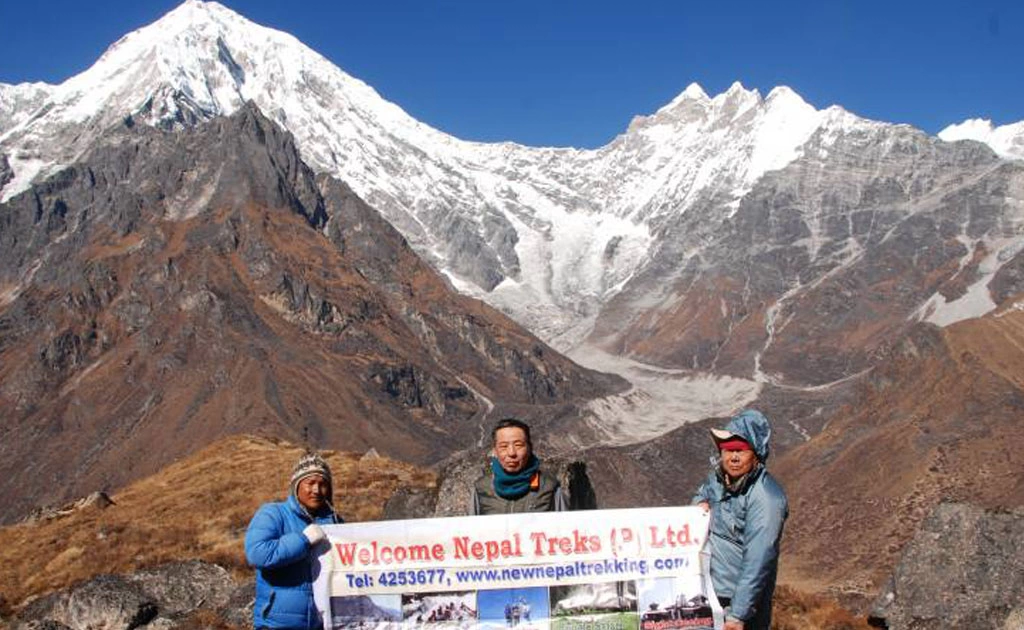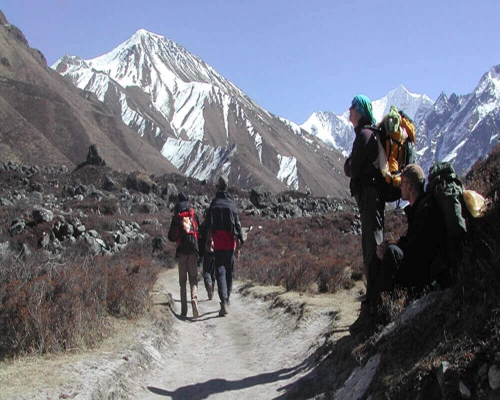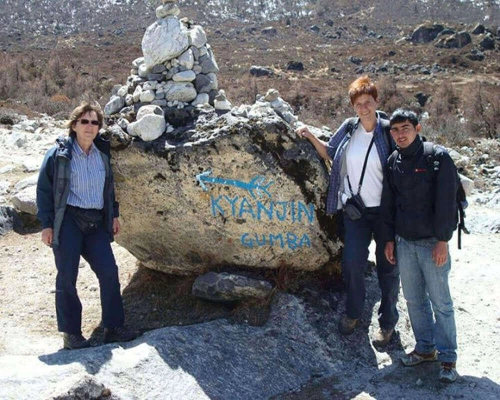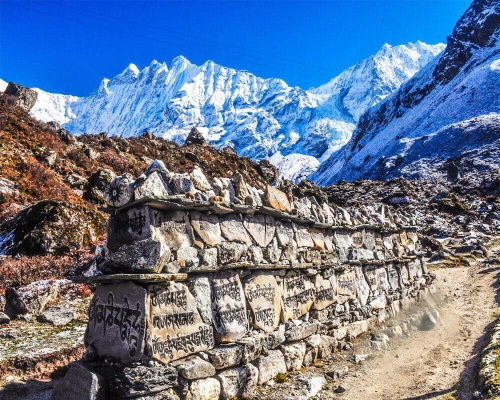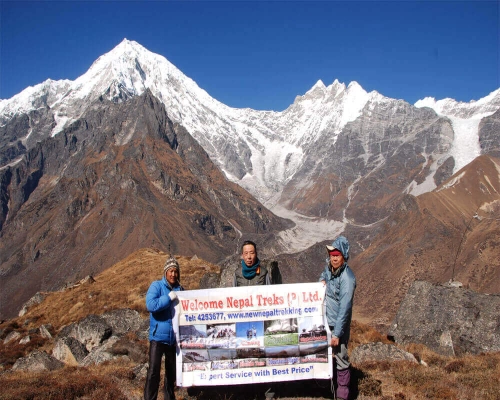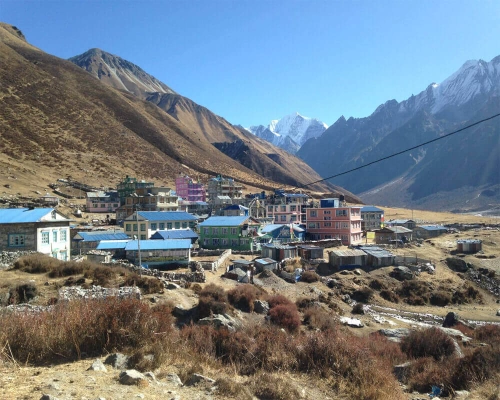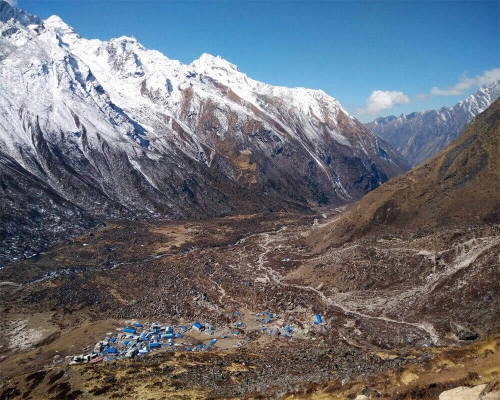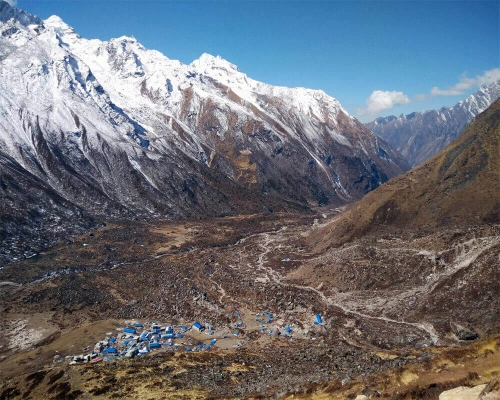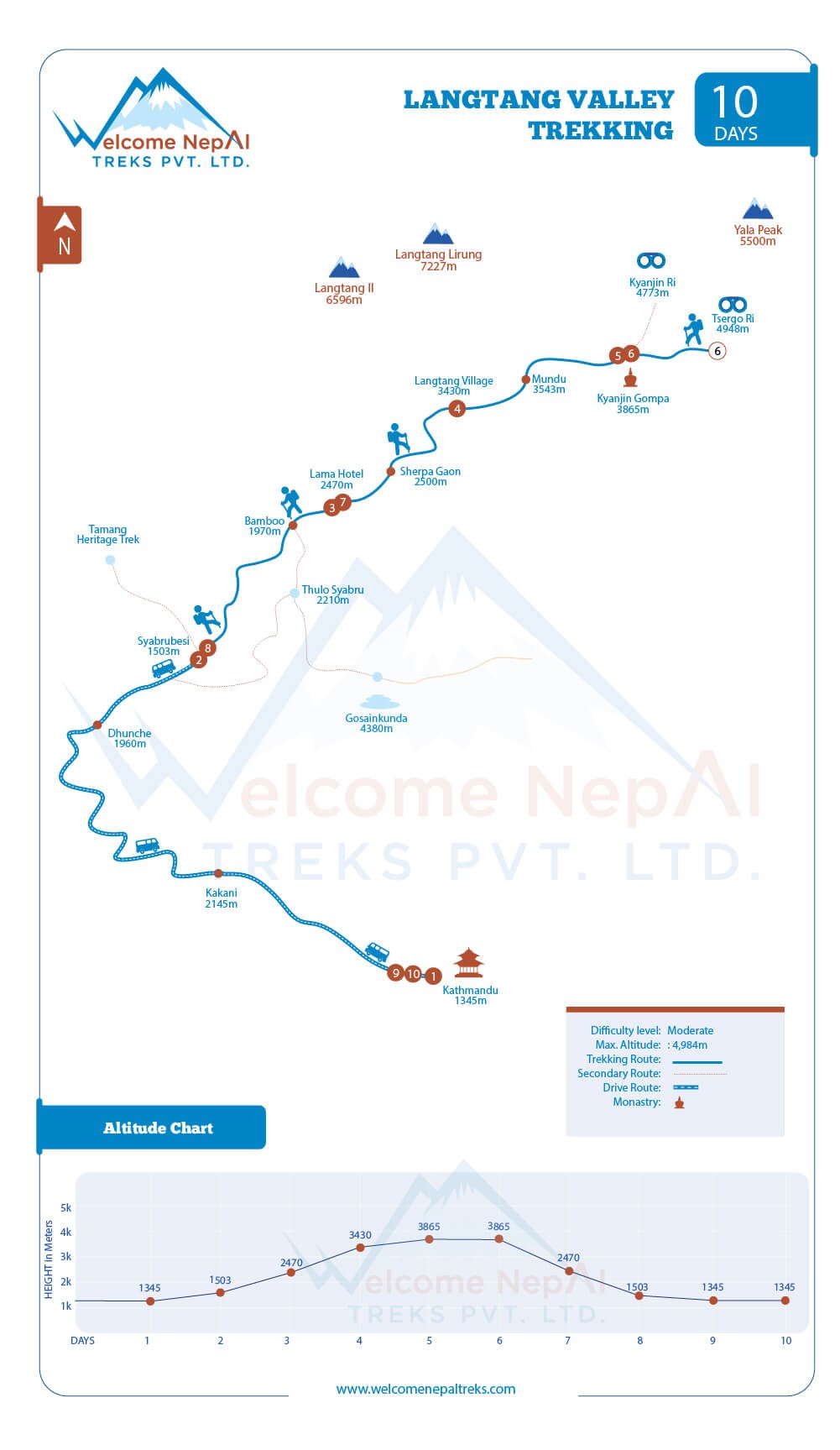Private Trek to Langtang Valley
Choosing a private trek to Everest Base Camp is a great option for those who want a custom, flexible, and deeply engaging adventure. Langtang Valley Private Trek lets you plan your own route, go at your own speed, and visit places you find most interesting without following a group's schedule. This flexibility guarantees a more relaxed and enjoyable experience, tailored to your preferences and fitness level. You will also have dedicated guide who ensures you experience enhanced safety and gain a deep understanding of the region's culture and natural wonders. Furthermore, you can pick your accommodations and meals, which ensures you're comfortable and satisfied during your trip. Private treks also let you adjust plans easily if the weather changes or if you have personal needs, reducing stress and increasing enjoyment.
Langtang Valley Group Joining Trek
Joining a group trek to Langtang Valley offers several benefits, making it a popular choice for many adventurers. Trekking with a group gives you a chance to connect with fellow travelers who share your passion. You'll build friendship and create lasting memories as you swap stories, support each other, and enjoy the journey together. This social aspect enhances the overall experience, making the trek more enjoyable and fulfilling. However, group treks to Langtang Valley are often more cost-effective, as expenses for guides, porters, and logistics are shared among participants, making it an economical option. Moreover, a group trek comes with a planned itinerary and fixed schedule, offering a structured and organized framework that can be comforting for those who prefer less planning and more guidance.
Alternative Packages of Langtang Valley Trek 10 Days
We have many adventurous trekking packages in Nepal, whether you are looking for a long trek or a short trek. These are some of our famous short treks that you may like to do- Mardi Himal Trek, Ghorepani Poon hill trek, short Everest base camp trek, short Annapurna base camp trek, Everest view trek, 7 days lower Mustang trek, etc.
Similarly, click on the respective links to see our budget-friendly trekking packages and luxury trekking packages in the Himalayas. Travelers also love yoga treks a lot these days.
For more information, we kindly request you to talk to our travel assistant. They will help you find the most suitable trekking package for you. You can also go through our site.
Langtang Valley Trek 10 Days Difficulty
Langtang valley trekking is for anyone who can walk 5 to 6 hours a day on a rough trail. It is a high-altitude trek with a gentle pace. Our Langtang valley trek itinerary will give you a lot of time to walk freely and stop at different locations to rest & relish the views. It's an easy to moderate trek with constant ascends & descends. You'll be walking through dense forests, crossing streams and rivers on mountainous terrain. Likewise, the accommodation on the trail and the meal options are limited, so you have to adjust to what is available.
Altitude Sickness During Langtang Valley Trek 10 Days
Altitude sickness is common during high-altitude journeys and is also avoidable & curable. The highest point of the Langtang valley trek is 4,984 meters at Tserko Ri. We begin trekking from Syabrubesi, located at 1,600 meters. The altitude increase from 1,600 m to 4,984 m in four days is drastic, so you may get symptoms of altitude sickness while trekking if not acclimatize.
We have rest days in our itinerary that lets trekkers rest and walk. Likewise, we also make sure the group is not ascending more than 500 meters a day and taking all the precautions. The team leader will take care of you in the mountains, so no need to worry.
Below are some early symptoms of altitude sickness. If you get any of these or feel any discomfort, inform the team leader immediately.
nausea
problem in breathing
headache
loss of appetite
insomnia
vomiting
How to Prepare for Langtang Valley Trek, 10 Days ?
To prepare for the Langtang trek, book the trek on time and have a few weeks on hand to get ready for the trip. Regularly exercise, go on day hikes if possible, and walk 5/6 hours a day. The most important thing during the Langtang valley trekking is, you should be able to walk at least 6 hours a day. So, building the habit is very important.
Trekking in Langtang National Park does not require you to do any advanced training. You can do simple things like swimming, cycling, running, jogging, etc to improve your stamina. Focus on your stamina and core strength.
Best Time to Do Trek to Langtang Valley Trek 10 Days
Trekking in the Langtang region is most adventurous and pleasant when the trail is bloomed with numerous flowers & vegetation and has a mild climate. And it's spring and autumn. The months from March to April and October to November are a perfect time of the year weather-wise to do the Langtang valley trek 10 days. You get to enjoy a pleasant trek, and the mountain views are stunning too.
You'll not face rainfall or snowfall in the spring and autumn seasons. The temperature ranges from 18C to 5C (lower to higher elevation). If you want to do a trek in winter, then we suggest going in early December or late February for the best trekking experience. Trekking in the Langtang valley during the monsoon is the worst time. The trails are muddy and slippery. The mountain views are blocked, and there are huge risks of landslides.
Accommodation During Langtang Valley Trek, 10 Days
We stayed overnight in a guest house during the Langtang valley trekking. The accommodation we use on the trail is simple. The rooms are small and twin shared with a common washroom. You'll be spending the nights in the home of the locals and therefore get to live an authentic mountain lifestyle. The guest house offers a comfortable bed and clean blanket for a good night's sleep. However, you still may feel cold in the mornings and nights, so carry a good-quality sleeping bag.
Meals During Langtang Valley Trek, 10 Days
The meals we have during the trek are simple yet delicious. We'll be having a Nepali staple dish, dal bhat with veg or non-veg curry as our heavy meal during the trek. This option has all the nutrients and energy to keep us going on mountains. You'll have both veg and non-veg options.
It's better to choose veg because most of the time, meats are not well frozen and may give you an upset stomach. Confirm with the service provider how old the meat is before having it. There are other options, such as roti, stir-fried veggies, momo, noodles, Tibetan bread, thukpa, sandwich, etc.
Travel Insurance For Langtang Valley Trek, 10 Days
Get travel insurance that covers emergency air evacuation and medical bills for Langtang valley trekking. You'll need travel insurance to trek with us. The Langtang valley trek has underlying risks like altitude sickness and other unseen events, so we need travel insurance as a back up to keep you safe in any emergency. We try our best to avoid any mishaps, but we cannot guarantee a 100% safe trek in the Himalayas.
Trekking Guide & Team For Langtang Valley Trek, 10 Days
To accompany you while trekking, a professional mountain guide and porters will be there with you in the mountains. We'll assign you a native mountain guide from the Langtang region who will make the trek very immersing. All of our guides are experts in leading groups in the Himalayas and have numerous years of experience, which makes them very reliable.
Similarly, our office team will be assisting you from the day you book the Langtang trek with us. They'll help you with preparation & packing and answer all of your queries. If you have any questions or requests, feel free to inform our team.
General Information Regarding Langtang Valley Trek, 10 Days
Charging: To charge your electronic devices while trekking, you can carry a solar charger and a power bank. There are charging facilities in the guest houses, but you may have to pay a few bucks.
Internet: Instead of relying on getting WiFi on Langtang valley trekking, we suggest you buy a Nepali sim with data to use the internet. This is much more economical and gives you the freedom to use the internet anywhere. The network may not be good throughout the route, but you'll get ample opportunities to share your moments with your friends & families.
Luggage: Extra luggage you can store in the hotel you are staying. They provide a locker room free of cost to store your luggage while trekking. During the trek, we use a duffel bag as the main carrier of our trekking gear, and the weight limit is 10 kg per person.
Permits: You'll need a Langtang National Park permit, which costs $15 for SAARC nationals and $30 per person for other nationals (both excluding 13% VAT). Along with that, you'll also need a TIMS card, which costs $10 for an organized trek and $6 for SAARC nationals. Independant trekkers have to pay $20.
Emergency contact: In any emergency, you can get in touch with us at this number- +977 9841767236 (Hari). This number has our Whatsapp & Viber. You can call or text at your convenience. Calling us will give you an instant response.
ATM & money exchange: First thing, there is no ATM on Langtang valley trail and the locals do not accept foreign currency or any kind of card. In Kathmandu, you can use your cards to pay for services at most places. Likewise, you can withdraw money from almost all ATMs, but you may get charged certain money by the bank. Money exchange centers and banks in Thamel will help you exchange foreign currency into the Nepali rupee.
Nepal Visa: It's a simple process to get a Nepal visa. You can apply for a Nepalese visa at the consulate office or Nepalese Embassy in your home country. Travelers from some countries can get a visa on arrival at all entry borders of Nepal. So, check your visa status.
Risks During Langtang Valley Trek
10 days Langtang valley trek is generally safe and popular trekking destination. But it is essential to be aware of potential risks and take necessary precautions to ensure a safe and enjoyable experience. Following are the risk during Langtang valley trek:
- Altitude Sickness
- Weather changes
- Slippery trails
- Landslides and avalanches
- River crossings
- Physical exhaustion
- Dehydration
- Trail Hazards
- Wildlife Encounters
- Remote Locations
Preventing Altitude Sickness (AMS) During the 10 Days Langtang Valley Trek
Preventing altitude sickness is significant for a safe trek in the Langtang valley. Here are some measures to help you avoid altitude sickness during your 10 days Langtang valley trek:
- Gradual Ascent
- Acclimatization Days
- Stay Hydrated
- Avoid Alcohol and smoking
- Eat Well
- Recognize Symptom
- Descend if Necessary
- Keep Warm
- Rest Well
- Avoid sleeping pills
- Know Your Limits
What Gear and Equipment for 10 Days Langtang Valley Trek?
- A few pairs of Thermal tops
- Fleece jacket/pullover
- Windcheater - waterproof shell jacket one pair
- Down jacket
- Comfortable Fleece/wool trousers
- Trekking pants- at least 2 pairs
- Thermal or woolen hat
- Mittens/woolen gloves
- Warm Hiking socks
- Hiking boots or sturdy trekking shoes
- Hiking Cotton trousers/t-shirts
- Sun hat/scarf, wash towel
- Sunglasses(with UV protection)
- Sunscreen (with high SPF)
- Trekking map and guidebook
- Portable charger for electronic devices
- Sleeping bag
- Trekking poles
- Day bag above 40 L
- Waterproof cover for backpack
- Headlamp or flashlight
- Personal toiletries (toothbrush, toothpaste, biodegradable soap, etc.)
- Basic personal first aid kit
- Snacks and energy bars
- Water bottles, water purification tablets
Distance and Time During 10 Days Langtang Valley Trek
The 10 days Langtang valley trek is a beautiful and rewarding journey that typically takes around 10 days to complete, covering a total distance of approximately 80 to 90 kilometers (50 to 56 miles). The trekking duration can vary based on your walking pace, acclimatization days, and the specific route taken. But on average you need to walk about 11 kilometers per day to complete the trek.
Can I Book Private 10 Days Langtang Valley Trek?
Yes, you can book a private 10 days Langtang valley trek through welcome Nepal treks. A private trek allows you to have more flexibility and personalized services during your journey. You can choose your trekking dates, itinerary, and even the level of accommodation and services you prefer. When booking a private trek through welcome Nepal treks, you can discuss your preferences and requirements with us. We will help you design an itinerary that suits your interests and needs. We will also arrange necessary permits, transportation, experienced guides, porters, and accommodation for you.
Can I Join the Group on 10 Days Langtang Valley Trek?
Yes, Welcome Nepal Treks offer group joining for 10 days Langtang valley trek. You can join a group for the 10 days Langtang valley trek through us. To join a group trek, you can inquire with welcome Nepal treks. We will provide you with information about the departure dates, group size, and cost of the trek. You can choose a departure date that aligns with your travel plans and preferences. Likewise, joining a group trek can be a fantastic way to experience the beauty of Langtang Valley while making new friends and sharing the adventure with fellow trekkers.
What is the Cost of the 10 Days Langtang Valley Trek?
The cost of 10 days Langtang valley trek can vary based on several factors, including the type of trek (private or group), the level of services and accommodation, the season of trekking you choose. According to the service, accommodation provided by us (Welcome Nepal Treks), we offer the 10 days Langtang valley trek at a very reasonable price. We offer this 10 days adventurous and splendid Langtang valley trekking package around $900 with the quality services. The cost includes the transportation fees and everything mentioned in the package with all meals.
Why 10 Days Langtang Valley Trek with Us?
Welcome Nepal treks have been operating for many years and has extensive experience in organizing treks in Nepal. Welcome Nepal Treks offers a splendid trek package to the customers at a very reasonable price with great services. We provide flexible and customizable itineraries tailored to your preferences, fitness level, and available time. We provide you the experienced guides and staff who possess in-depth knowledge of the trekking region. We can offer valuable insights, information about the local culture, and ensure a well-organized trekking experience. We prioritize safety and have established safety protocols in place. We ensure that our guides and staff are trained in first aid, altitude sickness, and emergency procedures.
10 Days Langtang Valley Trek Booking and Payment Policies
If you want to book the 10 days Langtang valley trek with Welcome Nepal Treks then, we need the photocopy of your passport and you have to pay us a minimum of 10% payment of the total cost as advance. You can pay us through different medium like cash, bank transfer, or online. We accept booking deposits through Credit Cards (Master Card or Visa and many more). You can also pay us direct cash. We also accept your last minute booking but the booking should be done at least before one day prior to the trip departure date. If you have any question regarding the trek, then feel free to contact us.
Trip Extension After 10 Days Langtang Valley Trek
After completing the 10 days Langtang valley trek, there are several options for extending your trip and exploring more of Nepal. Here are a few popular destinations and activities that you can consider:
- Ghorepani-Poon Hill Trek
- Chitwan National Park
- Pokhara
- Bandipur
- Annapurna base camp trek
- Manaslu circuit trek
- Everest Region
- Upper Mustang trek
- Nagarkot
- UNESCO World Heritage Sites like Kathmandu Durbar Square, Swayambhunath, Boudhanath, and Pashupatinath
- Trishuli, bhotekoshi rafting
- Mardi Himal trek
- Tlicho lake trek
Laundry Facilities During 10 Days Langtang Valley Trek
During the 10 days Langtang valley trek, laundry service is generally not available at the teahouses or lodges along the trail. The teahouses in the Langtang region are basic and provide essential facilities for trekkers, but they do not typically offer laundry services due to limited resources and the remote nature of the trekking route. It is advisable to bring enough clean clothes to last the duration of the trek. You can plan your clothing items based on the number of trekking days and pack lightweight, quick-drying materials.
ATM and Money Exchange Service During 10 Days Langtang Valley Trek
During the 10 days Langtang Valley trek, you'll have limited access to ATMs and money exchange facilities, especially once you start trekking into the remote areas. Before starting the trek, Kathmandu is the best place to access ATMs and money exchange facilities. Thamel has numerous banks and money exchange counters where you can withdraw cash or exchange foreign currency. The availability of ATMs and money exchange facilities can change in the Langtang region. So, it’s advisable to carry enough Nepalese Rupees in cash for your entire trekking duration.
Tipping on 10 Days Langtang Valley Trek
Tipping on the 10 days Langtang valley trek is a common practice and appreciated by the trekking staff for their hard work and services. Tipping is not mandatory, but it is a way to show your gratitude and appreciation for the efforts of the guides, porters, and other support staff who make your trek enjoyable and safe. Tipping is a way to acknowledge the hard work and dedication of the trekking staff who make your journey possible.
